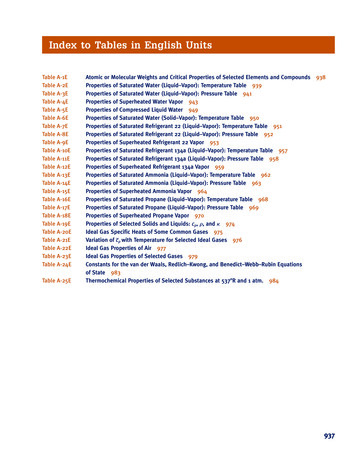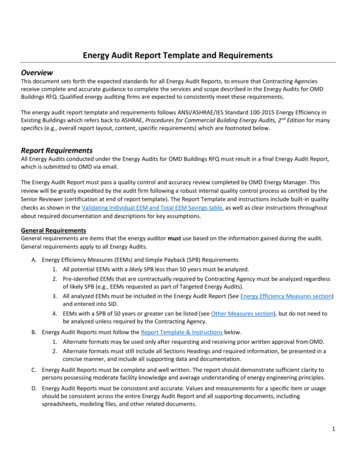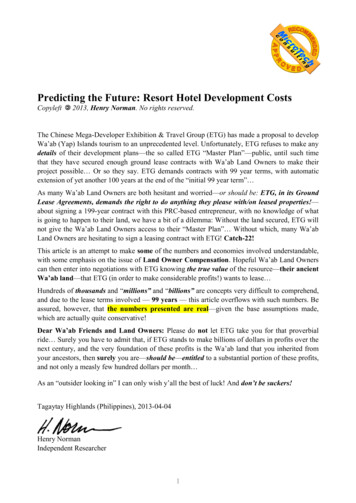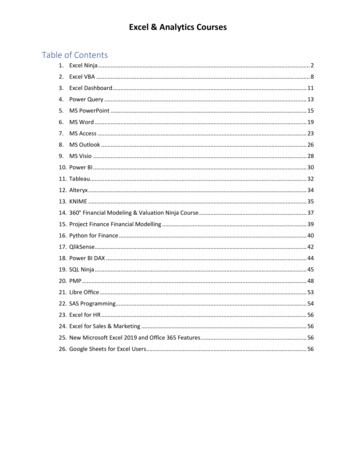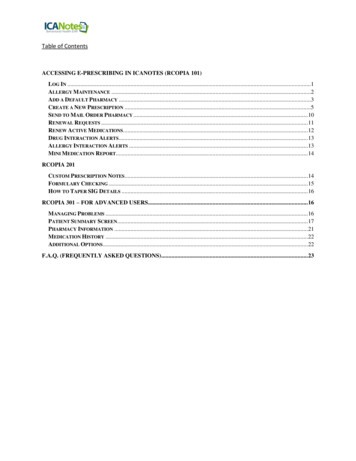
Transcription
Table of ContentsACCESSING E-PRESCRIBING IN ICANOTES (RCOPIA 101)LOG IN .1ALLERGY MAINTENANCE .2ADD A DEFAULT PHARMACY .3CREATE A NEW PRESCRIPTION .5SEND TO MAIL ORDER PHARMACY . 10RENEWAL REQUESTS . 11RENEW ACTIVE MEDICATIONS . 12DRUG INTERACTION ALERTS . 13ALLERGY INTERACTION ALERTS . 13MINI MEDICATION REPORT. 14RCOPIA 201CUSTOM PRESCRIPTION NOTES. 14FORMULARY CHECKING . 15HOW TO TAPER SIG DETAILS . 16RCOPIA 301 – FOR ADVANCED USERS. 16MANAGING PROBLEMS . 16PATIENT SUMMARY SCREEN . 17PHARMACY INFORMATION . 21MEDICATION HISTORY . 22ADDITIONAL OPTIONS. 22F.A.Q. (FREQUENTLY ASKED QUESTIONS) . 23
Accessing e-Prescribing in ICANotesYou can access e-Prescribing in ICANotes from several areas of the program: From the Chart Room, by pressing the “# Pending e-Rxs” or “# e-Rx Renewals” buttons at the top of theChart Room (these serve to remind the user of pending renewal, refill, or partially completed e-Rxentries). From the Work Areas of a note, specifically the Medication List in Progress Note Part 2. From the patient’s Demographics page in ICANotes using the Go to e-Prescribe button at the top of thepage.When you access e-Rx from ICANotes, it will take you directly to the patient’s chart. Otherwise, you will type in thepatient’s name or ID to locate their chart. E-prescribing will launch onto either the Patient Summary screen shownbelow, or the Allergy Maintenance screen (see Page 2).1
In either instance, you can enter in the patient’s pharmacy by clicking on Change below the patient’s name at thetop of the screen to the right of the Pharmacy link. For directions on how to choose a pharmacy skip to thePharmacy Information section on page 3. To proceed to the directions on how to prescribe, go to page 5.NOTE:Demographics, Medication Reconciliation, Clinical Summary, and Clinical Order Sheet are not setup for two-way integration between DrFirst and ICANotes and require double entry. Currentdemographics will sync from ICANotes to DrFirst when you enter the e-prescribing module, but ifyou update demographics in the e-prescribing system, that data will not sync with thedemographics in ICANotes.The first new note you create for an existing patient who you have previously prescribed meds to from ICANoteswill require a 10-20 second sync. Please be patient while the information is uploaded to DrFirst. Note: Do not “X”out of the screen during the sync process.Patient allergies are not transferred to the e-Prescribing module from ICANotes, so you will first need to enter thepatient’s allergies from the Allergy Maintenance screen shown below.1. Click on Manage Allergies2. Enter the patient’s allergy history. There are three different ways for entering your patient’s allergyinformation.a. If your patient has no known allergies, click the Indicate 'No Known Drug Allergies (NKDA)' linkat the topb. Select a common allergy from the drop down menu and click Add Common Allergyc. Enter search criteria for your patient’s allergy, click Find and select the appropriate allergy2
i. Entering non-drug related allergies: Enter the allergy (peanuts) and click Find. ClickEnter free text ‘peanuts’ as allergy at the top of the list.ii. Note: A red triangle next to an allergy (peanuts) indicates that Rcopia does notconduct a drug-allergy checking because this allergy was entered manually.3. After you select the desired allergy, select the appropriate reaction such as hives or nausea and onsetdate (optional)4. Click Add5. Repeat steps 3 - 4 for each allergy6. After you have entered all of your patient’s allergies, click Done With Allergiesa. You will now be taken to the Patient Pharmacy Information screenAdd a Default Pharmacy1. To add a pharmacy for a patient, click on Change to the right of Pharmacy below the patient’s name.2. Select the pharmacy list you would like to search froma. Favorites List – contains only the pharmacies that the individual user has previously selected tobe in their favorites listb. Practice List – contains only those pharmacies located in the first three numbers of the practice’szip code3
c. All List – contains all available pharmacies in the Rcopia database. Since this mostcomprehensive list, this is usually the desired way to search for pharmacies.3. Enter the search criteria for the pharmacya. Note: The less information you enter, the more successful your search results may be. Start withthe city and zip code and maybe the first few letters of the pharmacy name.4. Click Find5. Click on the desired pharmacy’s name to attach it to the patient’s recorda. “24” next to a pharmacy’s name indicates the pharmacy is open 24hrsb. (E) next to a pharmacy’s name indicates the pharmacy accepts electronic prescriptions.Pharmacies without an (E) will receive a fax from Rcopia.c. “No fax” next to a pharmacy’s name means that the pharmacy does not accept any faxesd. For information on mail-order pharmacies, see the “Pharmacies” section of the user manual.6. After adding the desired pharmacy, your patient has been successfully added to Rcopia and you maybegin to prescribe for this patient.4
Create a New PrescriptionThere are four main ways you can create a new prescription for a patient. Be sure you have selected a patientbefore creating a new prescription.1. Drug Searcha. Enter in your search criteriai. Less is more – enter the first few letters of the drug nameb. Click Findc. Select the desired form and strengthi. Note: Capitalized medications are the brand name versions of the drug. Medicationslisted in all lower case are the generic versions of the drug. The designation (otc) nextto the strength indicates that this medication does not need a prescription and can bepurchased over the counter. Formulary information may or may not be present. Seethe formulary section for more informationd. Continue to the Enter Details section.5
2. Drug Category Searcha. Click Category Search. This allows you to look up all medications within a specific therapeuticclassb. Click the icons to expand each category until you find the desired form of the drugc. Click the desired form of the drugd. Continue to the Enter Details section3. Favorite Prescriptiona. Select the desired prescription from the Favorites drop-down menub. Click Use to create the prescription and add it to the pending prescriptions at the bottom of thepagec. Click View/Edit to make changes to the prescription before creating the prescriptiond. Continue to the Enter Details section6
4. Active Medicationsa. Note: This method can only be used if the patient has an active medication historyb. Find the medication in the patient’s active medication list on the Patient Summary screenc. Click Prescribed. Continue to the Enter Details sectionEnter Details:1. Verify the provider and pharmacy fields are correct and select the appropriate values from the dropdown menus for the SIG (instructions) details.a. If you used a Favorite Prescription or an Active Medication to create this prescription,verify/change the SIG details as necessary.2. Click Continuea. If you need to change the drug, click Change Drug.b. Click Cancel to cancel the prescription7
3. Review prescription4. Click one of the action buttonsa. OK – adds the prescription to the Pending Prescription listb. Back – allows you to edit the SIG detailsc. Cancel – cancels prescriptiond. Add to Favorites – adds current prescription to your Favorites list.5. After clicking OK, your prescription is added to the Pending Prescriptions list on the Patient Summaryscreen.a. Note: The Add to Meds check box is selected by default so that the prescription is added to thepatient’s active medication and history6. You are then taken to the Patient Summary screen.7. Scroll down to the Pending Prescriptions section on the Patient Summary screen8
8. Select the desired prescriptions you want to process9. If you are a provider, enter your Signature Password10. To complete, click one of the options provided:a. Send – Transmits the prescription to the pharmacy electronically.b. Send and Print – Transmits the prescription to the pharmacy electronically and prints out a copyof the prescription for your records.c. Print w/o sending – Prints the prescription without sending it to the pharmacy. This is useful ifthe patient is unsure which pharmacy he or she would like to use or for controlled substanceprescriptions.d. Sign w/o sending – Adds the medication to the patient’s active medication list. This is useful ifyou gave the patient a sample.Controlled substances in schedules II-V must be printed and cannot be sent electronically to the pharmacies unlessyou upgrade to EPCS Gold e-Prescribing. For schedule II medications (this is denoted next to the drug as II), youmust print these prescriptions and give them to the patient. For schedule III-V, you must print the prescription, signit, and then you can manually fax it to the pharmacy for the patient, or hand it to them to take to the pharmacist.9
Send to Mail Order PharmacyMail order pharmacies are given for patients who show eligibility obtained from Surescripts.Note: Only when eligibility is obtained for your patient can you send to a mail order pharmacy, such as Caremark,Express Scripts, Medco, etc. You will notice when you log into Rcopia and pull up a patient if a formulary appearsfor the patient then the system may provide a mail order option.You will see the mail order listed in 3 places:1. When you get to the Pharmacy Information page, you will notice above the search boxes for retailpharmacies, you will see the mail order pharmacy that the patient is eligible.a. You do not have to choose the pharmacy from here. Our recommendation is to choose the retailpharmacy the patient uses so that you can get this on file and be able to send prescriptions toboth pharmacies at the same time.2. You will find the mail order pharmacy automatically added to the drop down list of pharmacies for thepatient found under their name and phone number in the Patient Demographic Information box at thetop of the Prescribe screen.3. The patient’s mail order pharmacy will appear on the Enter details page, or Sig page, where you will beentering the details for the prescriptions you are prescribing.a. Below the provider drop down you will find the default pharmacy for the patient, and directlybelow that you will find the mail order pharmacy that the patient is eligible .i. There will be boxes to the left of both the retail pharmacy and the mail orderpharmacy.10
b. You then have the option to check just the mail order box to send a 90 day prescription, or bothboxes and send a prescription to the retail pharmacy as well as the mail order.i. This will allow the patient to get their prescription from the retail pharmacy and starttheir medication while waiting to receive the prescription in the mail order pharmacyRenewal RequestsRenewals requests are electronic requests generated by a pharmacy for the patient and you will have a link to viewthese messages in your EMR. Click on this link and you will be launched into Rcopia through the portal onto therenewal request screen with your pending renewal request.1. Click Renewal Requests (XX) at the top of the screen in the blue toolbar2. Select the desired action from the dropdown menu for each renewal requesta. Deny – Will deny the request for a Renewal and sends a denial message to the pharmacy.b. Change – Allows you to change the prescription and/or pharmacy information. When change isselected, and the prescription is changed, the prescription becomes a pending prescription inthe appropriate provider’s prescription report. This will alert the pharmacy that the requestedrenewal has been denied, but a new prescription will follow.c. Renew plus, X refills – Renews the prescription with a desired amount of additional refillsd. Forward – Allows a staff member to forward the prescription request to another qualifiedprescriber in their practice.e. Remove – Should only be used if you have previously handled this request and it is a duplicate.11
3. If necessary, select Pharmacy Notes from the dropdown menu or type them into the box to the right4. If necessary, enter comments in the comments box. They are visible only to you and your office staff.5. After you have selected an action for each request, enter your Signature Password at the top or bottomof the screen and click Perform.6. All requests that have an action will be executed.Renew Active MedicationsFor patients with an active medication list, one or more medications can be renewed at a time.1. Click Renew Selected to renew all of the medications on this patient’s list at once. (Rcopia automaticallyselects all the medications in the patient’s list)2. Click Select None to unselect all of the medications so you can manually select a desired number ofmedications from the list.3. Once you have selected the medications you wish to renew, click Renew Selected.4. You can renew a particular medication by clicking Renew to the right of the listed medication.5. You can change the details (Sig, Duration, Quantity, Renewal, Pharmacy, etc.) of a prescription by clickingon the Prescribe link to the right of the listed medication.12
6. You can stop a medication by clicking the [Stop] link to the right of the listed medication.a. You will be prompted to enter a reason for stopping this medication.i. Best practice: Enter a specific reason for stopping the medication and it will bedisplayed in the patient’s medication history.Drug Interaction AlertsWhen prescribing medications, Rcopia will always check against the active medication list for drug to druginteractions. The alerts will appear after you have searched for the drug and chosen the strength. These alerts willappear in RED, as shown here:DRUG INTERACTION ALERT! This patient is being given Lipitor (atorvastatin), which has a severe incidence ofadverse effects when combined with the drug you have just prescribed, erythromycin. [See Reference]. Proceedwith extreme caution.These alerts will have a See Reference link that allows the user to view an Interaction Report. The user will also begiven the ability provide a justification for prescribing this medication notwithstanding the warning, this isoptional.Allergy Interaction AlertsWhen prescribing medications, Rcopia will always alert you if you are prescribing something that is associated witha drug on the list of allergies and adverse reactions. The alerts will appear after you have searched for the drugand chosen the strength. These alerts will appear in RED, as shown here:ALLERGY ALERT! This patient is listed as having an allergic reaction (unspecified) to amoxicillin, which is identicalto the drug you have just prescribed, amoxicillin. Proceed with extreme caution13
The user will also be given the ability provide a justification for prescribing this medication notwithstanding thewarning, this is optional.Mini Medication Report1. To print a wallet-sized version of a patient’s current medication and allergy list, click Mini on the patientsummary screen once you have selected a patient.a. This is an ideal way for patients to keep track of the medications they are currently taking.2. The Mini Medication Report will then open in a new window.a. Note: If you have disabled pop-up blockers, the print window will automatically display so you canquickly print a copy for the patient. See example below:3. To close that window, click the X or Close button in the upper right corner of the title bar.Custom Prescription Notes1. Custom prescription notes can be created by clicking on Additional Options on the blue navigationtoolbar at the top of the screen and going to Preferences – User.2. At the very bottom of the screen you will find a box, which allows the user to enter customizedprescription notes that will be available to select while prescribing medications.a. A custom prescription note can be any length desired.b. Do not hit the return key while typing the prescription note, let the text wrap on its own.c. Hit the return key to delineate between individual prescription notes.14
d. You will find these notes in a drop down on the sig page above the Directions to Patient box.e. These can be very helpful and are the next best thing to creating favorite prescriptions.3. When finished, click on the Make These Changes.Formulary CheckingFormulary information in Rcopia is obtained from Surescripts1. When you pull a patient up the system will automatically start searching for his/her eligibility using thepatient’s first name, last name, zip code, and DOB.a. Surescripts provides formulary information for health plans and payers such as Blue Cross,Anthem, Mamsi, etc.b. They do not provide eligibility for government funded formularies or some small payers.2. Once the formulary information is obtained the system can tell you what medications may be coveredand not covered by the patient’s insurance.a. If you try to prescribe a medication that is not covered, or has higher co pay, you will receive aformulary alert in the system.3. The user can override these alerts or select from the list of alternatives and prescribe a medication thathas a lower co pay.15
How to Taper SIG DetailsIn order to taper a sig in Rcopia:1. Use the drop downs provided on the Rcopia Prescription Form page or Sig page to start the sig or leavethem blank.a. You can also go down below where the Directions t
ACCESSING E-PRESCRIBING IN ICANOTES (RCOPIA 101) . You can access e-Prescribing in ICANotes from several areas of the program: From the Chart Room, by pressing the “# Pending e-Rxs” or “# e-Rx Renewals” buttons at the top of the Chart Room (these serve to remind the user of





